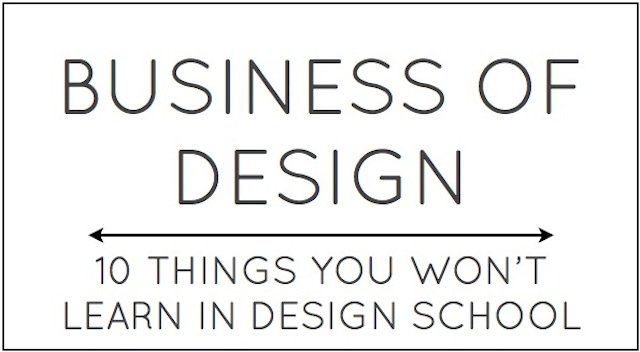BUSINESS OF DESIGN:10 THINGS YOU WON'T LEARN IN DESIGN SCHOOL
There have been many times that I have heard designers lament about how design school didn't prepare them for a career in design. Usually, it's just a single focus, one of those I've listed below that they feel were missing from their formal design education.
I've been thinking about doing this post for about 3 years, so it is a culmination of conversations I've had with dozens of designers. I should tell you that every school has different curriculum and the designers I spoke to did not all go to the same school. I also focused on residential interior designers who are self-employed or their ultimate goal is to be.
I've always said that it is important to work for someone else before navigating this wondrous world of self-employment and that is where you'll learn the most important lessons in being an interior designer. It's the experience that can't be taught in school. "I feel like some of these things you fully don't grasp until you apply them in real life, said Chicago designer Edyta Czajkowska.
I've heard from many that design school provides the fundamentals, some used everyday and others as useful as calculus, but it could better prepare a designer for anything other than a career working for a large design firm. As my friend Claire Watkins put it, "Even if it's not the graduates' responsibility, clients don't come out of nowhere, books don't balance themselves and the government isn't going to tell you what to pay in taxes. I think it would be helpful for every grad to have their eyes open on these ideas and the 'behind the scenes', not just 'here's my role - and I'll blindly perform it'".
10 THINGS YOU WON'T LEARN IN DESIGN SCHOOL
1. Interior Design is a business first, then an art. Forget color boards and room schemes - what you should be learning about is sales and bookkeeping.
2. Client Acquisition. Where do you find clients and once you find them how do you convince them to work with you?
3. Budgets & Costs. Many design schools are working with outdated materials or give hypothetical (and often unrealistic) prices on furniture, fixtures, and other elements that make up a house.
4. Problem solving - Interior design is really just solving one problem after another and those analytical skills need to be exercised. Tiffany Rene states, "I've noticed how even some 'top designers' are oblivious to what it takes to coordinate a successful installation. Likewise, they specify furnishings without any regards to what it would actually take for the installers to move the item(s) into the space which is how we end up with crane and hoist situations."
5. Business finance & accounting - I've heard from some that they had great business of design classes and others had zilch. My friend and former co-worker Leah Talanian, says "Yes I was warned, unfortunately it was too late, of all the time doing the business side and paperwork. So a stronger class in time management and an organizational skills class for the business side would have been great!"
6. Client psychology. Interior design is up-close and personal. Understanding client psychology plays a large role in how projects get done and why clients do what they do (They're crazy. Kidding. I'm kidding!). Connection, understanding, and communication in integral in the design process.
7. Setting Fees. This is such a hot topic in interior design right now and it seems like people can't stop talking about it. How to make money doing interior design would be a great class in design school.
8. Hands-on experience. Several designers expressed the desire for more real-world experience in school. From role-playing client meetings and presentations to visiting actual construction sites.
9. What a contact or letter of agreement looks like. Designers told me that this subject was never addressed in school and if it was it was just stating the necessity to have one, not what it might contain. It's not surprising then, that my post Anatomy of Interior Design Agreement is the #2 result on Google when you search "interior design contract".
10. How houses are built. "Being on a jobsite and learning more about construction documents would definitely have been more valuable. Learning a bit more about HOW a house is built and reading those details on blueprints would’ve been a great additional part of design school training," said Kristin Hazen. Fellow Phoenix designer, Julie White echoes, " (In school) there was too much theory and focus on concepts without enough detail of construction and how things are built. I feel that designers need to somewhat know how things are made in order to design something that's possible to be built."
If you're considering going to school for interior design, remember that each program is very different. Ask about hands-on experience, if the teachers and instructors are currently working in the field, and what sort of jobs graduates get. Obviously, if you're looking to work for yourself one day, you'll need to find a program that can prepare you for that. You'll want teachers who are working as interior designers today, because the field is very different than it was even 5 years ago.
If you liked this post, I'd love to hear your thoughts in the comments below.
PS: You also might like Business of Design: Best Practices or my series 10 Things Interior Designers Won't Tell You.
PSS: This is probably one of my longest posts ever at over 900 words. Whew!
PSS: If you're interested in business training for interior designers visit www.thegoldenblueprint.com

